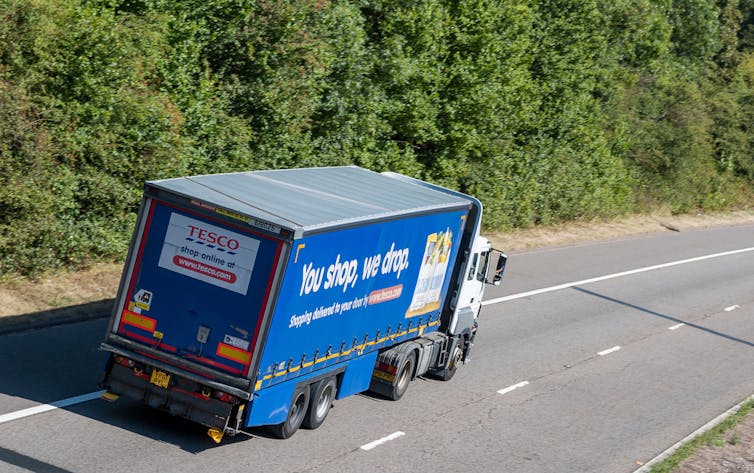Extreme hot and cold weather in the UK will have driven up average household food prices by £45m a week in 2018, according to recent research from the Centre for Economic and Business Research. Cue numerous press articles laying out the details of the damage, focusing almost entirely on the supply and demand problems with farms. In reality, this story is not quite as it seems.
It is indisputable that extreme weather affects farmers. The CEBR report points out, for example, that the price of onions was driven up by over 40% by the hot weather, while the damage to grass meant that butter prices went up by nearly a quarter. But the extent to which prices go up because of farmers taking advantage of shortfalls in supplies elsewhere is often exaggerated. In fact, in many cases farm gate prices are not massively affected by supply and demand.
It’s much more common for prices to vary because of what is happening further up the supply chain, with food processors and retailers. It is easy to blame the weather for price rises, but this is actually an excuse, masking serious underlying problems in the supply chain. So what is the cause of these price hikes and how can this be avoided?
Kinks in the chain
For the past three years, I have visited many UK food retailers and manufacturers big and small to get a better understanding of what happens on the ground. Prior to this, I concentrated on visiting the equivalent players in various other European countries. Because these visits usually come with non-disclosure agreements, I can’t get into many specifics about individual organisations: what follows are some general observations about what I see again and again in my research.
Over the years, the major food retailers in the UK and other countries have developed a distribution model where a few massive storage hubs commonly supply supermarkets all over the country. The majority of products pass through these hubs, regardless of how far they have to travel on either side. This system cuts back on any number of additional costs from having lots of smaller warehouses, but it is not good at adapting to extreme weather.
The warehouses are not close enough to supermarkets to respond quickly when conditions change. Lorries are in many cases not temperature controlled, so goods get ruined en route. And store managers tend to have very little autonomy when it comes to ordering, despite big variations in local demand and weather.
Run lorry run. Jaroslaw Killian
Another big issue is forecasting of demand. Many food processing companies will receive monthly orders from retailers, but these can get increased or decreased during the month depending on demand. Processors often just follow these orders and devote little or no time to looking at weather forecasts and, say, adjusting their raw materials requirement – or even ringing their buyer to see what difference it’s likely to make.
Good practice would be for these companies to forecast demand every week, with even more frequent mini reviews – daily in the case of very perishable goods like sausages or sandwiches. Retailers also need to communicate more early and often with suppliers to avoid bottlenecks.
Besides these problems, I have seen various other troublesome logistical issues. Raw materials not arriving on time to meet customer demand, for instance. Equipment breaking down because there hasn’t been any maintenance planning. These are avoidable – and many processing companies and retailers could improve contingency planning to have alternatives places when things go wrong.
Then there is waste. One UK study from 2010 estimated that food manufacturers lose about 16% of their raw materials during manufacturing, contributing almost a quarter of the total food wasted by food suppliers and households. Much can be prevented with management tools. There is excellent optimal inventory software, for example. Companies can adopt the likes of first in first out warehousing, product tracking and looking in detail at different parts of the supply chain to inform ordering decisions. I see these sorts of things much better used in Belgium and particularly the Netherlands.
More companies could also invest in a circular economy model where food is reused, redistributed and recycled to minimise waste. Supermarkets rejecting products for not being aesthetically pleasing remains a major problem, albeit with improvements like Morrisons’ wonky fruit and veg range. Processors, meanwhile, could better exploit alternatives such as farmers markets or, say, converting ugly produce into juice. Other measures that are too uncommon include using food waste for energy through anaerobic digestion.
Tech talk
New technologies can help with this optimisation. One is electronic data interchange (EDI) software, which allows companies to adjust orders and ensure appropriate stock levels with far less effort by staff. This minimises in-store waste, while maximising the on-shelf availability of products. The big UK retailers all use EDI, but smaller retailers don’t, and neither do many small or medium processors.
The Internet of Things has great potential, too. By enabling the likes of lorries and freezers and store shelves to all communicate with one another in real time, it should reduce the cost of production and prices. This is not emerging yet, but all players in the chain ought to be considering it as soon as it is available.
Tech-cellent. Billion Photos
Another big opportunity for the future is more flexible logistics. Take the ice cream company that doesn’t need as much storage space in the winter as in the summer. In the same vein as Uber or Airbnb, food processors and retailers could be making use of each others’ spare space, transport and even equipment.
The central point is that customers are often putting up with increased food costs when suppliers are to blame. The best functioning businesses are prepared for the unexpected. We shouldn’t obscure these issues by overfocusing on the supply and demand of the raw product. Food supply chain efficiency in the UK and other countries could be greatly improved in many ways, and it’s time people realised.



 Trump Hints at Major Autism Announcement, Raises Questions on Tylenol Link
Trump Hints at Major Autism Announcement, Raises Questions on Tylenol Link  Canada Loses Measles-Free Status After Nearly 30 Years Amid Declining Vaccination Rates
Canada Loses Measles-Free Status After Nearly 30 Years Amid Declining Vaccination Rates  U.S. Black Friday Online Spending Surges to $8.6 Billion, Boosted by Mobile Shoppers
U.S. Black Friday Online Spending Surges to $8.6 Billion, Boosted by Mobile Shoppers  Ethereum Ignites: Fusaka Upgrade Unleashes 9× Scalability as ETH Holds Strong Above $3,100 – Bull Run Reloaded
Ethereum Ignites: Fusaka Upgrade Unleashes 9× Scalability as ETH Holds Strong Above $3,100 – Bull Run Reloaded  Eli Lilly’s Inluriyo Gains FDA Approval for Advanced Breast Cancer Treatment
Eli Lilly’s Inluriyo Gains FDA Approval for Advanced Breast Cancer Treatment  CDC Shake-Up Sparks Vaccine Policy Clash Between RFK Jr. and Susan Monarez
CDC Shake-Up Sparks Vaccine Policy Clash Between RFK Jr. and Susan Monarez  Novo Nordisk and Eli Lilly Lower Prices for Weight-Loss Drugs Amid U.S. Agreement
Novo Nordisk and Eli Lilly Lower Prices for Weight-Loss Drugs Amid U.S. Agreement  Eli Lilly Becomes First Pharma Giant to Hit $1 Trillion Amid Soaring Weight-Loss Drug Demand
Eli Lilly Becomes First Pharma Giant to Hit $1 Trillion Amid Soaring Weight-Loss Drug Demand  Asia’s IPO Market Set for Strong Growth as China and India Drive Investor Diversification
Asia’s IPO Market Set for Strong Growth as China and India Drive Investor Diversification 


































